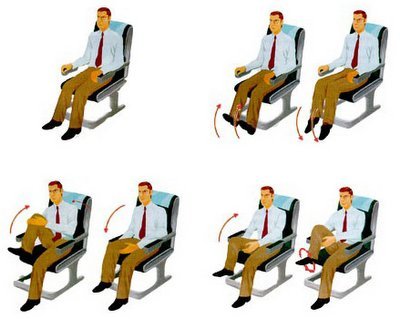The increase in aviation, better airports and the need to travel for business all have one downside: sitting around. You sit at the airport and wait for your flight, sit on your plane and then, in most cases, sit in a taxi from the airport to a hotel or home.
And with sitting comes the potential killer: Deep vein thrombosis (DVT). Looking to keep the Wise Traveller happy, healthy and hearty, we look at DVT and how to prevent it.
What is Deep Vein Thrombosis (DVT)?
DVT is a blood clot that can originate from a person's legs. If a clot breaks, it will travel through the arteries and block the arteries to the lungs. This can cause a pulmonary embolism, which if not treated immediately, will prove fatal.
What are the risk factors?
The more hours you sit immobile or in a sedentary position—think flight delays, and you could be seated for hours—the risk of DVT can rise. The more you fly, and the longer you fly for, means more sitting, and so long-distance travellers will be at an increased risk of DVT.
A frequent traveller should also factor in several variables that increase DVT-risk.
This includes being overweight; age can play a role; if a person has an associated hereditary blood-clotting condition; the family has a history of blood clots; those who smoke, or have had lower body operations, such as knee surgery.
How to recognize DVT?
Those that fear they have DVT should be looking out for these signs to see if they have it.
Either they may have reddened skin, or experienced swellings of the leg, ankle or foot, as well as a warm feeling in the leg, cramping of the calves or tenderness in the leg.
However, DVT can be overlooked, and it is when they are under treatment for a pulmonary embolism that the diagnosis becomes clearer.
 For those suffering an embolism, the symptoms can include light-headedness, rapid breathing, shortness of breath, coughing up blood and an irregular heartbeat.
For those suffering an embolism, the symptoms can include light-headedness, rapid breathing, shortness of breath, coughing up blood and an irregular heartbeat.
How to beat DVT?
There are numerous safe and common sense ways to prevent DVT.
The first is to recognise that sitting for long periods is not great for your health. So get up and move around, even if it is to walk the aeroplane's gangway to prevent blood pooling in your lower limbs.
Take a look at your health and consider lifestyle changes. If you are overweight, find a better diet and a gym. If you smoke, reducing smoking can reduce DVT incidents.
More straightforward solutions, including leg exercises while sitting in the taxi, in the airport lounge or on the plane, will help keep the blood circulating.
See also: Long Haul Flight Survival 101
Wearing compressions stockings or socks—which help to contribute to healthy blood flow in the legs by graduating compression—are also an excellent solution.
If you're taking medicine, then research their risk contributing to DVT and consider any side effects. Likewise, take preventive medication to decrease the risk of DVT.
Get to know your family's history. Having relatives who have suffered clots can raise the risk of your future DVT problems.
Consult your family doctor to assess the risks before embarking on regular travel. And, no doubt, you'll be sitting down when the news is delivered!
 Andy Probert left the British rat race after a 25 year as a journalist and PR specialist to live in Turkey and now Cyprus, a compulsive traveller his favourite places include Vietnam and India among many. Among the travel Andy continues to write freelance and still maintains a PR client base.
Andy Probert left the British rat race after a 25 year as a journalist and PR specialist to live in Turkey and now Cyprus, a compulsive traveller his favourite places include Vietnam and India among many. Among the travel Andy continues to write freelance and still maintains a PR client base.















